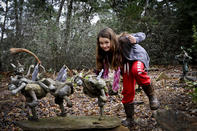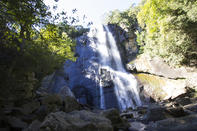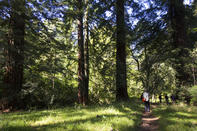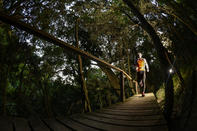A Misty, Fairy World
Hogsback is part of another world - a misty, magical place where fairies and goblins live. There are flowers everywhere, creeping up signposts and over mossy stones.

The town clings to forests on the edge of the Hogsback Mountains; the road leading up to it is feathered with arum lilies and tall forests - a fitting transition from the rugged Eastern Cape to a misty, fairy world. The town's human inhabitants are artists, poets, writers, chefs - people who've been lured to the dorp by its tranquil atmosphere. You find them in the B&Bs and restaurants hidden among the trees.
Hogsback Waterfalls

These falls are not superlative in terms of height, nor breath, nor volume of water, or any other physical measure. What makes the multiple waterfalls around Hogsback so special is their inherent magic, the same magic that draws travellers there as if in a lotus-eating trance. There's just something about the place, isn't there?
Something elusive, always somehow just out of grasp. While the Madonna and Child Falls is a short stroll from the heart of the village, visiting the Kettlespout and Swallowtail Falls involves quite a stiff walk. Tuyme Falls is quite a bit further still, requiring you to backtrack along the Amatola Trail until you reach the edge of an escarpment, high above Keiskammahoek Valley.
Dontsa Pass
Two species which are particularly common here, and among the easiest forest trees to identify, are the knobwood (Zanthoxylum davyi) and the lemonwood (Xymalos monospora) which, together with the coast coral tree, red beech and coffee pear, reaches its southernmost limit here.
The lemonwood is often an untidy tree, the flaky bark exposing the yellow wood beneath with its conspicuous geometric patterns and whorls. It often forms extensive coppices and, with its heavy foliage, excludes other species; this is usually a sign of a degraded area, as is evident throughout this hike. The knobwood, with its chunky, knobbled armour, needs no introduction, and in the Dontsa area it appears to be ubiquitous.
The Heathland

As the climate has fluxed, so the woodlands and heathlands have ebbed and flowed up and down the highlands as rainfall has allowed. In East Africa these heathlands are found only on the highest, wettest places, such as on Kilimanjaro, Mount Kenya and in the Rwenzoris.
As one moves south the heaths are found at lower and lower altitudes, above 2 500 m in the Drakensberg and a little lower than that here. In the Western Cape, the climate is such that these so-called 'alpine' heaths are able to thrive at sea level, as well as on the highest mountains, where they have found environmental conditions just right to flourish.
The Amatola Trail

Of all the official hiking trails in South Africa, the Amatola is king. Each of the six days is very different in aspect and character, as are each of the overnight huts. 'Amatola' are young cattle that every summer, since time immemorial have been driven by Xhosa herders to these high pastures for fattening.
The Amatole Mountains are the southernmost outcrop of Afro-Alpine mountain habitat, very much like the Drakensberg but, for reasons of geography, are more grassy and have far more extensive Afro-montane forests. The total distance is 106 kilometres, which works out to an average of nearly 18 kilometres a day, much of it pretty steep.
So it's a demanding trail, but so lovely and rich in natural splendour you will hardly notice. When you reach the Hogsback forests, and village of the same name, you'll think you've entered an entirely magical world. The trail has more waterfalls and pools than you could ever wish for. By halfway on day four you'll stop counting them, although day five has even more, mostly in a system of interconnecting gorges and gullies.
Hogsback Walks

There are several short walks in the area around this quaint mountain hamlet, and it's also one end of the six-day Amatola Trail. There are marked 'Piggy' and 'Blue Crane' trails, but these are mostly short walks near the village. Longer outings are up Tor Doone conical peak, with its fire-watch tower, and the three Hogsbacks.
If peak bagging isn't your game, take a walk via interesting places like the Eastern Monarch yellowwood tree and the Madonna and Child, Swallowtail and Kettlespout Falls, then stroll along the Tyume River to the Tyume Falls and back. With the whoop of Samango monkeys and the craak of turacos never far off, it'll be a rewarding outing.
By David Bristow